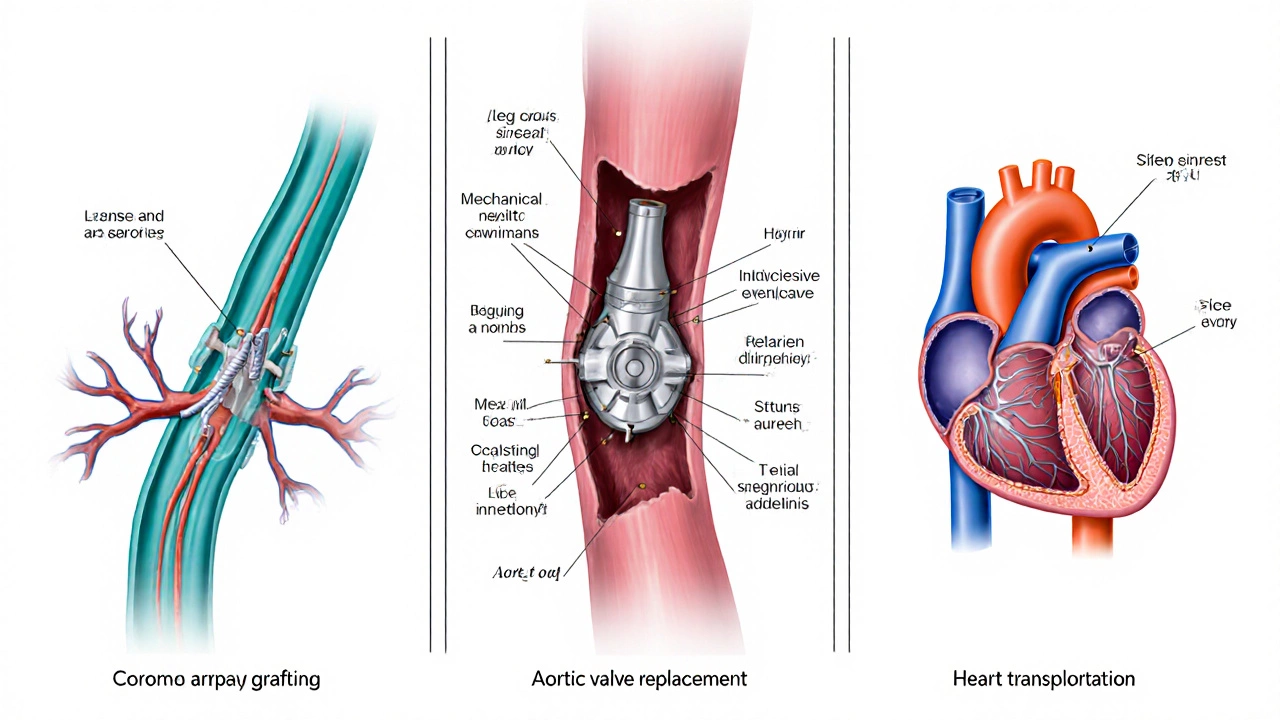Heart Surgery Survival Estimator
Calculate Your Survival Estimate
Estimated 5-Year Survival
Key Takeaways
- Average 5‑year survival after most major heart surgeries ranges from 70% to 90%.
- Type of surgery, age, and pre‑existing conditions are the biggest drivers of life expectancy.
- Good postoperative care - medication, rehab, and lifestyle changes - can add several years.
- Heart transplant offers the longest median survival, but donor availability limits its use.
- Regular follow‑up with a cardiologist is essential to catch complications early.
When you hear the phrase heart surgery life expectancy, you probably wonder: "Will I get back to a normal life?" or "How many more years can I realistically expect?" The answer isn’t a one‑size‑fits‑all number. It depends on the exact procedure, your health background, and how well you stick to the recovery plan. Heart surgery is a broad term that covers any operative intervention on the heart or its major vessels. It includes procedures like coronary artery bypass grafting, valve replacement, and heart transplantation. Each of these surgeries has its own survival statistics and recovery timeline.
How Doctors Measure Life Expectancy After Surgery
Survival data usually come from large registries such as the Society of Thoracic Surgeons (STS) database or national health databases. The most common metrics are:
- 30‑day mortality - the chance of dying within the first month.
- 1‑year survival - a snapshot of early recovery and complication rates.
- 5‑year survival - the benchmark many clinicians use to gauge long‑term success.
- Median life expectancy - the age at which half the patients are still alive.
These figures are averages. Individual outcomes can be better or worse based on personal risk factors.

Major Types of Heart Surgery and Their Typical Outcomes
Below are the three most common categories of cardiac operations, each with its own survival profile.
Coronary artery bypass grafting (CABG) involves taking a healthy blood vessel (often from the leg) and routing it around a blocked artery to restore blood flow. CABG is the go‑to surgery for severe coronary artery disease.
- 30‑day mortality: 1‑3% for elective cases.
- 5‑year survival: roughly 80% for patients under 65, dropping to 70% for those over 75.
- Long‑term benefit: many patients gain 5‑10 extra years of symptom‑free life.
Aortic valve replacement (AVR) replaces a diseased aortic valve with a mechanical or bioprosthetic valve. It’s often done when the valve is severely narrowed (stenosis) or leaky (regurgitation).
- 30‑day mortality: 2‑4% for traditional open‑heart AVR, under 2% for minimally invasive approaches.
- 5‑year survival: 85% for patients under 70, about 75% for older cohorts.
- Durability: bioprosthetic valves last 10‑15 years, mechanical valves last longer but need lifelong anticoagulation.
Heart transplant replaces a failing heart with a donor organ. It’s reserved for end‑stage heart failure when other surgeries can’t help.
- 30‑day mortality: 5‑10% (higher than other surgeries because patients are sicker).
- Median survival: about 12‑15 years in the United States; 20‑year survival rates hover around 50% for younger recipients.
- Key limitation: donor shortage means long waiting lists.
Factors That Influence Your Post‑Surgery Life Expectancy
Even within the same procedure, outcomes can swing dramatically based on the following variables.
Age is a strong predictor - younger patients generally recover faster and have lower mortality rates.
Pre‑existing conditions such as diabetes, chronic kidney disease, or chronic obstructive pulmonary disease (COPD) raise the risk of complications.
Left ventricular function measured by ejection fraction (EF) shows how well the heart pumps. An EF below 35% signals higher postoperative risk.
Postoperative complications - infections, bleeding, arrhythmias, or kidney injury - can cut life expectancy by years if not managed promptly.
Medication adherence (antiplatelets, statins, anticoagulants) dramatically lowers the chance of repeat events.
Cardiac rehabilitation programs that combine supervised exercise, nutrition counseling, and psychosocial support improve 5‑year survival by 15‑20%.

How to Boost Your Odds for a Longer, Healthier Life
Here’s a practical checklist you can start using today.
- Stick to prescribed meds. Missing a dose of a blood thinner or statin can undo months of progress.
- Enroll in cardiac rehab. Even a 12‑week program can add several quality‑adjusted life years.
- Quit smoking. Smoking cuts post‑CABG survival by up to 30%.
- Manage weight and blood sugar. Obesity and uncontrolled diabetes double the risk of repeat surgery.
- Follow up regularly. Routine echo and stress tests catch problems before they become life‑threatening.
Quick Reference: Average Life Expectancy by Surgery Type
| Procedure | Median Life Expectancy (years) | 5‑Year Survival Rate | Typical Patient Age |
|---|---|---|---|
| Coronary artery bypass grafting (CABG) | 12‑15 | 80% (under 65) / 70% (over 75) | 55‑70 |
| Aortic valve replacement (bioprosthetic) | 10‑12 | 85% (under 70) / 75% (over 70) | 65‑80 |
| Heart transplant | 12‑15 (average), up to 20 for younger recipients | 50% (10‑year) / 30% (20‑year) | 30‑55 |
Frequently Asked Questions
What is the average life expectancy after a CABG?
Most studies show a median survival of 12‑15 years for patients under 65, with a 5‑year survival rate around 80%. Older patients still see a meaningful benefit, though the 5‑year rate drops to about 70%.
Does a mechanical valve give a longer life expectancy than a tissue valve?
Mechanical valves last longer (often >20 years) but require lifelong anticoagulation, which can introduce bleeding risks. Tissue valves avoid anticoagulation but typically need replacement after 10‑15 years, which can affect overall longevity.
How much does cardiac rehabilitation improve survival?
Participating in a structured rehab program can boost 5‑year survival by 15‑20% compared to patients who skip it, according to data from the American Heart Association.
Are there any lifestyle changes that can add years after heart surgery?
Yes. Quitting smoking, maintaining a BMI under 30, eating a Mediterranean‑style diet, and exercising at least 150 minutes a week are all linked to adding 2‑5 extra years of life after surgery.
What are the biggest risks that could shorten life expectancy post‑surgery?
The most common threats are postoperative infections, chronic kidney disease, uncontrolled diabetes, recurrent heart attacks, and poor medication adherence.

 Why Am I So Angry After Open-Heart Surgery?
Why Am I So Angry After Open-Heart Surgery?
 Do You Eat Meat in Ayurveda? What the Classics and Modern Experts Say
Do You Eat Meat in Ayurveda? What the Classics and Modern Experts Say
 How to Choose the Best Herbal Supplements: Expert Tips for Safe Buying
How to Choose the Best Herbal Supplements: Expert Tips for Safe Buying
 The Darker Side of IVF: What You Need to Know
The Darker Side of IVF: What You Need to Know
 Affordable IVF Clinics in the United States: Finding the Best Options
Affordable IVF Clinics in the United States: Finding the Best Options